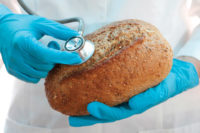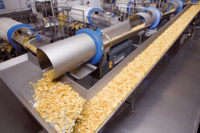The emphasis on food safety has been constantly shifting and evolving. Traceability was an initial focus; then came the Hazard Analysis Critical Control Point (HACCP) practices, which impacted manufacturing. More recently, the Global Food Initiative was created to improve food safety supply chain management.
Many predict the Food and Drug Administration’s (FDA) Food Safety Modernization Act (FSMA), which was passed by Congress in December 2010, and signed into law by President Obama on Jan. 4, 2011, will be the game changer.
The FSMA, which is the most massive food safety legislation passed in the last 75 years, is designed to help the food industry prevent, detect and respond to food safety issues more quickly as well as address the safety of imported foods. The bill gives the FDA the authority to inspect records; conduct a mandatory recall when a company refuses a voluntary recall; charge fees for facility re-inspection when a mandatory recall is required and the facility failed a prior inspection; require certification of compliance for imported food; establish whistleblower protection; detain products when safety is a question; and increase inspection frequencies of high-risk facilities.
The FSMA requires the FDA to prepare approximately 50 documents dealing with guidance and regulations necessary to carry out the FSMA. The first of the proposed regulations are due out in early 2012.
“As part of the bill that is slowly being rolled out, there are 52 regulations and guidance documents that have to be proposed and then put into final form,” says Lee Sanders, senior vice president of government relations and public affairs at the American Bakers Association (ABA) in Washington, D.C. “We were expecting proposals to come out on preventative controls in October, then that was put off until January. Now, we were just told it will be several months until completion.”
The biggest of these is Section 103 Hazard Analysis and Risk Based Preventative Controls and requirements on imports. “This is just one of several new regulations to come forth from the FMSA, but will be a very labor-intensive requirement for food processors and distributors to understand and implement,” says Gale Prince, founder and president of Cincinnati-based Sage Food Safety Consultants.
It’s important to note that the FSMA affects all commercial bakeries and snack food manufacturers that were required to be registered with the FDA under the 2002 FDA Bioterrorism Act. This would include all commercial bakeries and food distribution locations where food is stored.
“When the final regulations are issued in the next few months to support the FSMA, firms will be required to conduct a hazard analysis of their ingredients and finished products as it relates to the potential for contamination from unintentional and intentional sources, and establish preventative controls to mitigate these hazards,” says Prince. “Firms will also be required to conduct verification studies to prove that the preventative controls are adequate. The authority of the FDA to be able to see and copy production and quality control records is a new element of the FDA inspections.”
A close watch
Despite the delays, industry organizations and associations are keeping a close eye on recent FSMA developments and educating members on the regulations and requirements.
“Some of the FSMA regulations have not been written yet, and we expect more details will come out in the next year or so,” says Maureen C. Olewnik, Ph.D., vice president of audit and technical services at AIB International, Manhattan, Kan. “Our members are trying their best to stay on top of it and get the necessary initiatives in place.”
Food safety will also be the key theme at the Washington, D.C.-based Independent Bakers Association’s 38th annual conference this June.
“We’ve seen a continuing evolvement of the regulatory process,” says Nicholas Pyle, association president. “Gone are the days of GMP (Good Manufacturing Practices), which were replaced by HACCP, and now by a methodology that tracks the food industry from seed to stomach.”
Baking Equipment Manufacturers and Allieds (BEMA), Overland Park, Kan., will be addressing FSMA updates at its June meeting. “It’s one of our highest priorities right now,” says Kerwin Brown, BEMA’s president and CEO. “There are so many unknowns, and the industry is trying to work through it. From an equipment standpoint, manufacturers are doing all they can to get in compliance.”
Through its Regulatory Affairs Committee, the ABA reviewed the FDA’s proposals and prioritized what applies to baked goods in order to ascertain where the association can help shape the policy. “Larger companies will do fine, because they already have the resources in place to meet FSMA requirements, but compliance will be a stretch for smaller companies,” says Gerry Gomolka, vice president of process engineering for Stellar, a Jacksonville, Fla., firm that designs and builds manufacturing facilities.
Addressing the issues
The changing FSMA regulations aren’t the only challenge those in the industry are contending with in their food safety efforts. The two biggest issues for manufacturers are allergens and foreign material. “As a precursor to FSMA, the FDA came out with a food protection approach that included both food safety and food defense, which is something we have a lot of information on,” adds Olewnik. “There is a difference between product that is accidentally contaminated and that which is intentionally contaminated. Both are now part of FSMA.”
As the FDA broadens its food safety approach, the industry is coming up with new ways to understand, manage and implement the new regulations. Many anticipate that funding will be a big challenge to properly execute the procedures, testing and overall improvements that the FSMA will require. The Congressional Budget Office estimates that it will cost $1.4 billion over five years to implement the FSMA. To put this in perspective, Congress provided the FDA with $50 million for the program this year.
The FDA also will have to allocate extra money in the budget for the additional inspectors to accommodate the FSMA. “If the proper funding is not provided to do this big job, it will be hard to get it done,” Olewnik says. “Our industry will see improvements, but it will take time.”
This is because cost isn’t just an issue for the FDA, but also for the bakery industry as a whole. “We are a low-margin industry, so it will take time financially and internally to implement a lot of what they’re putting forward,” she points out.
The ABA, IBA and 29 other food industry organizations have opposed the FDA’s user fees, and recently sent a letter to Congress representatives asking that adequate congressional funding, rather than food taxes and regulatory fees, be used to finance food safety programs.
“We’re not opposed to re-inspection fees, but there needs to be accountability so as not to affect small bakers,” Sanders says. “As a result, we are helping to educate the FDA about bakeries’ unique distribution system to ensure the administration’s resources are used appropriately.”
Also at issue is the fact that many bakers may need to invest in new equipment and facilities to meet the FSMA’s regulatory requirements. “The current method of monitoring processes may not be adequate for verification under the new regulations,” Prince says. “This may require investment into expensive controllers, recorders and/or retrofitting or replacement of some pieces of processing equipment.”
In addition, bakers and snack food manufacturers also are dealing with significant costs to bring paperwork into compliance with the new food safety laws. “I’m not sure how one measures the cost of staff time in filling out this paperwork or handling FDA inspections,” Pyle says.
It’s not just the bakery that needs to be in compliance, but also its suppliers, including independent contractors and the people they work with. “This includes independent contractors receiving items at a central distribution point who are working with route drivers,” he adds. “This legislation carries mandatory recall authority, which is a new animal for many of these businesses.”
Track and trace
And even though most companies already have traceability programs in place, the FSMA is a cultural shift for many in the industry that will take time to adopt. The process is further complicated by ingredients sourced from overseas. “The supply chain is becoming very complex,” Olewnik explains. “There are some materials you can only find in different parts of the world. We need to find a way to partner with these companies to make sure the supply chain is safe.”
This will become increasingly important, as the FSMA traceability laws are enacted and enforced. “The FSMA’s foreign supply verification proposal will be important, since about 95% of our enrichment is coming from outside of the U.S.,” Sanders says.
Many predict that monitoring and tracking technology will be necessary to keep compliant with FSMA regulations. For example, the implementation of radio frequency identification (RFID) tags means manufacturers can be responsible for items well after they leave the bakery, adds Pyle. There will continue to be dozens of third-party auditors to assist those seeking to become compliant with the new food safety rules. “It’s not so much about what’s happening on the bakery floor, but also about what’s going on with record keeping,” he says.
Today, software programs are available to simplify this task. CDC Software, based in Atlanta, provides track-and-trace enterprise solutions for the manufacturing industry. “Most people are looking at track, trace and recall procedures with newer technological solutions,” says Jack Payne, vice president of CDC Software. “There are newer technology solutions now available, such as mapping type programs that make it simpler for people to view the necessary information.”
The FSMA comes at a time when the baking industry continues to be entrenched with sanitation issues, along with a multitude of audits that have been expanded rather than consolidated. “It’s very fractured right now, with nine different audits and an increasing number of food safety requirements,” Brown says. Currently, the baking industry is focusing on what’s required to get into compliance and putting those pieces into place.
“Companies are making sure they’re ready, as the new regulations are written and put out there,” Olewnik says. “It’s a matter of teaching, training and footwork for us and other industry organizations to bring the necessary information to our members.”
Education programs
AIB International has a number of food safety programs geared to help its members comply with the FSMA. Last year, the organization rolled out FSI 360, a food safety inspection program that emphasizes floor-type training and deep inspection to help ensure effective cleaning practices are in place.
AIB International also provides a number of webinars, seminars and onsite training for members. “A big area we’re involved in is one-on-one training that we can set up for our members,” Olewnik says. Two years ago, AIB International formed Food Safety Foodservice Providers to help educate those in the industry about third-party audits. “We also interface closely with the FDA and consumer advocacy groups to understand their issues and provide information on the complexities of the food industry as it relates to food safety,” she explains.
At presstime, AIB International was working on its next equipment and design workshop focusing on allergens and pathogens. “This will focus on how equipment can be better designed for easier and more thorough cleaning,” says Olewnik. “Over the long term, equipment providers and customers will partner in this.”
As legislation was passed into law, ABA held a webinar on the legal and practical implications for bakers. The association plans to hold another webinar once the new proposals come out.
BEMA recently began sponsoring a sanitation seminar focusing on allergen and pathogen control that will be held twice a year. So far, it has garnered sellout crowds.
Looking ahead
The full ramifications and impact of the FSMA probably won’t be evident for years to come, as the regulations continue to evolve and the industry comes to grips with the many changes. “Our members are looking very closely at the requirements and third-party auditors to tell them what needs to be done in order to be compliant,” Pyle says.
On the equipment front, there are opportunities for the development of safer machines that require less cleaning. “It’s a matter of designing out all the issues and making these units easier to clean,” Brown says. “When the equipment guys can make it easier to take apart and clean the equipment, that’s huge. Bakers can save a lot of money with less cleaning time. It adds to their bottom line.”
In an effort to improve the sanitary design of food equipment, the bakery and snack food industry is working on an update of the ANSI Z50.2 Sanitary Equipment Standard for Bakery Equipment, formally referred to as the BISSC Standard. Food safety as a culture has no end. These programs are ongoing, and even with the changes instituted by the FSMA, there is always more that will need to be accomplished.
“Whether the focus is on emerging pathogens or new ways to ensure food safety, the bar will continually be raised,” Olewnik says. “The culture will continuously be nurtured, as the industry looks for improvements on how to do things.”
To best accomplish this, the industry must work together. “It’s not just the baker’s issue, it affects everyone,” Brown points out. “The old rules don’t apply anymore. People have to adapt, change and get better in addressing food safety.”








